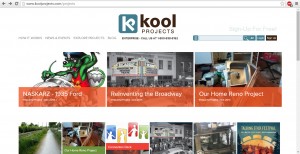While frequenting a coffee shop called Wick’s, I sometimes run into Michelle Mollineaux, CEO and Co-Founder of KoolProjects. A fledgling social media platform, KoolProjects allows users to showcase projects in progress—whether that’s antique car repair or a painting or historical building preservation—through images and text. I e-mailed Michelle the following questions, and she sent me this response:
CH: Can you describe how you approached designing KoolProjects?
MM: Customer driven design – we wanted to make sure that we were capturing the core workflows of our users and then incrementally building/adding/changing as we grew the product. We didn’t want to spend a ton of money building out a huge application only to find out that we had captured the wrong workflows or worse, in the time it took us to get to market – the features we built were no longer relevant. So we spent a lot of time talking to our potential market, understanding how they approached their products, what were important to them, and how they wanted to do things and then we captured that as part of our website workflows. Obviously, it’s a work in progress and as we gain more users, we learn and build/adapt the product to ensure that we adapt with our customers.
CH: What are you hoping that KoolProjects will offer people that they cannot get elsewhere? What makes it stand out?
MM: With KoolProjects – the focus is on the project and how to showcase the project. Unlike other sites that allow you to upload pictures of a project as part of your personal activities or profiles – with KoolProjects – it’s about the project and not about the person behind the project. By focusing on the project, we allow people to build communities of interest around common topics that are driven around common subjects/hobbies. It doesn’t matter if you know the owner of the 1969 Mustang restoration project because you the common interest is around the 1969 Mustang and not the owner of it. Obviously, we know that having these common interest leads to building more social networks and strong social bonds but that is a secondary effect of KP. The primary effect is building a community around a common interest first and then from there building a social network/relationship
CH: What was the biggest challenge you had when you were designing or planning the platform, and how did you overcome that?
MM: The biggest challenge was understanding the various project owners workflows and how to create a common approach to their workflow from a design and development perspective. Everyone’s project is unique and they approach from a unique perspective – once we mapped out the workflows of the various target customers we were going after, we were able to identify the common workflows/behaviours and move beyond the project/subject specific terminology. After we mapped out the flows, we ran it by the various target users to see if they could complete the various tasks specific to their project and from there we approached it iteratively to make sure we were fine tuning as much as we could given our available time and resources
CH: What do you have in mind for KoolProjects in the next few months?
MM: Obviously the number one thing is to expose more people to KoolProjects and get them to show case their projects on the site. Beyond that, we want to continue to evolve the product by moving into the mobile space using the same methodology we did with the website to ensure that we were capturing the core customer workflows that they would do on a mobile device, understanding that the mobile and desktop and tablet experience will be different and optimizing for each device.
I was interested in two things in particular: the focus on studying workflows and the focus on project rather than person. A lot of the social media we’ve discussed in this class has been built around a certain social identity (Facebook and LinkedIn making this especially central to their platform); Michelle emphasized that KoolProjects is not headed in this direction. We met in person on 20 February so that I could ask some follow-up questions on these topics.


